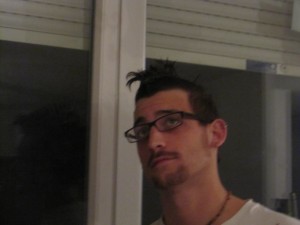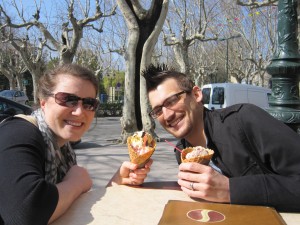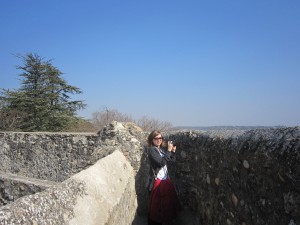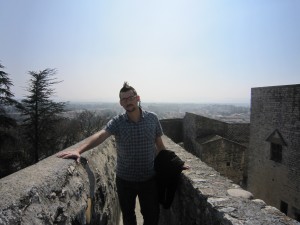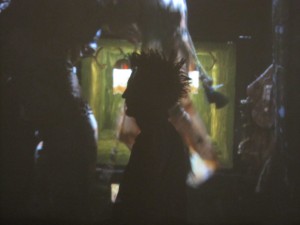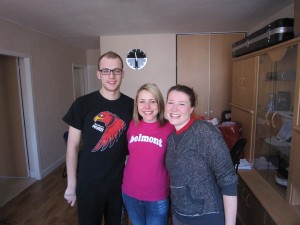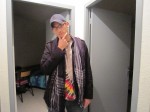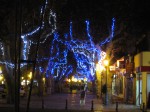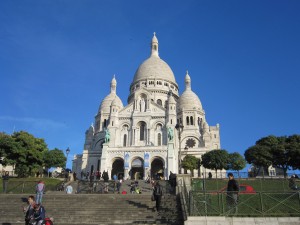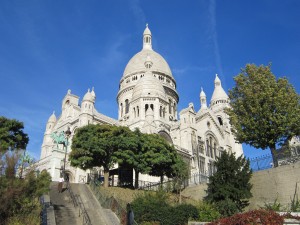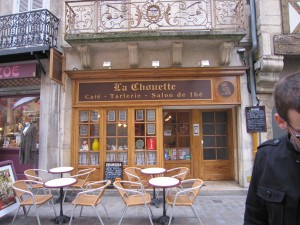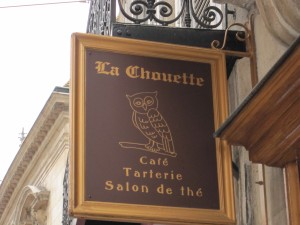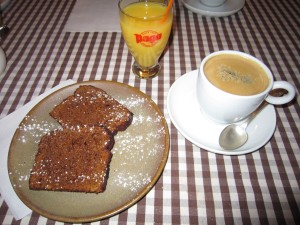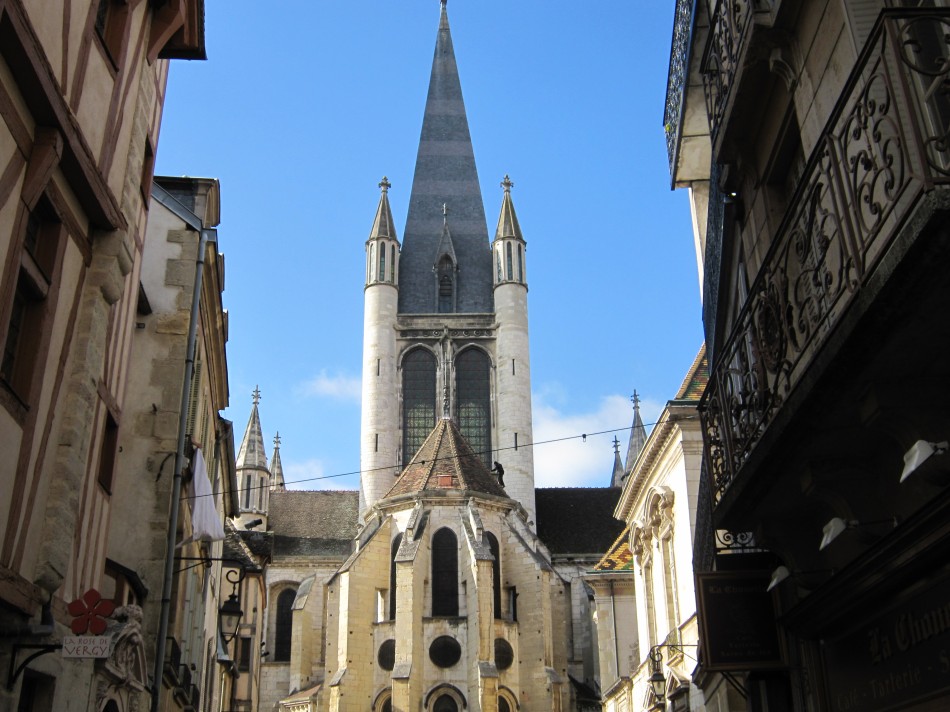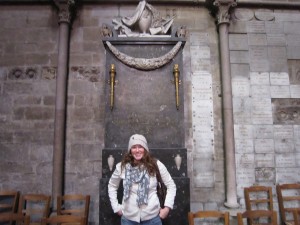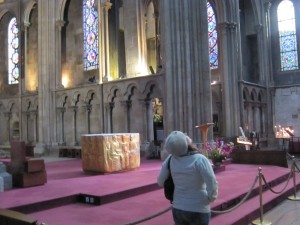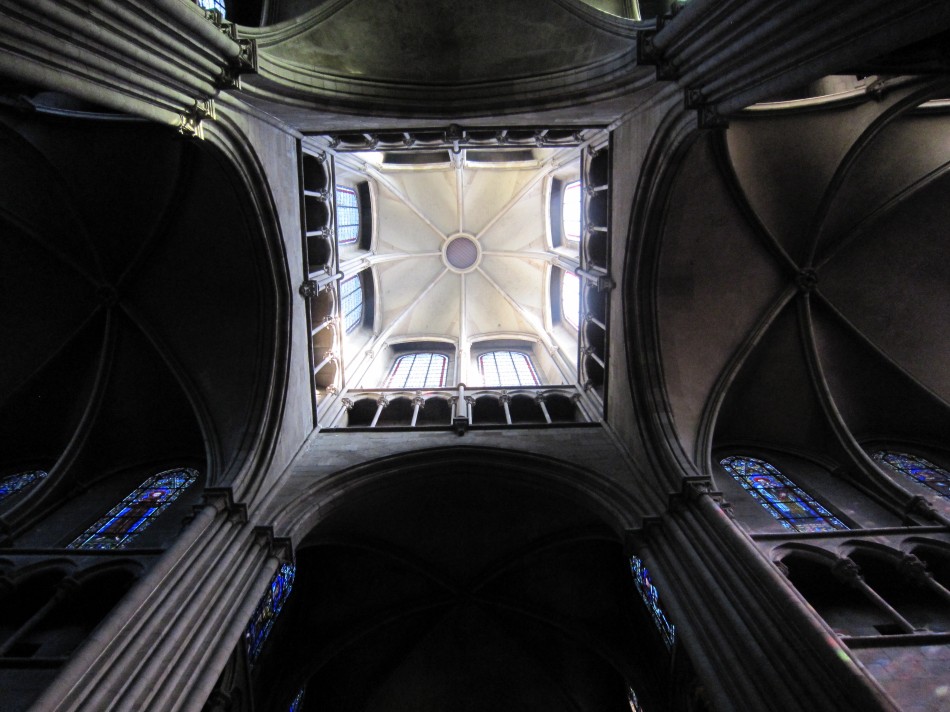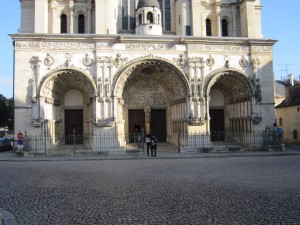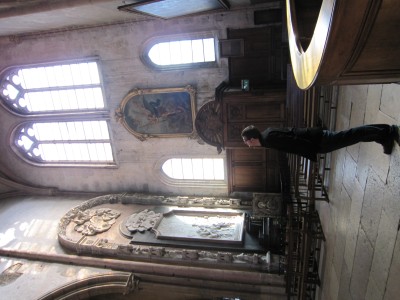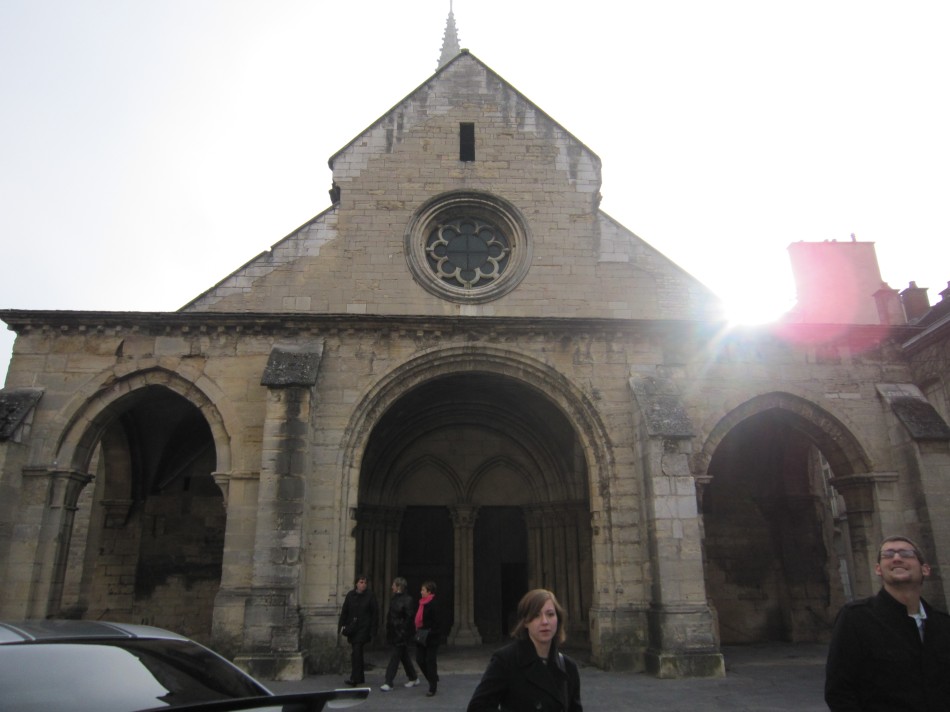Timeline: Pierrelatte: December 14th through 16th Orange day-trip: December 15th Lyon: December 16th through 18th Strasbourg: December 18th through 20th Paris: December 20th through 23rd Amsterdam: December 23rd through 27th
The Arrival and Pierrelatte:
The anticipation of waiting for Andy and Emily was almost too much for Kayley and I. For at least two weeks we’d been saying. “Well, you know, Andy and Emily will be here in two weeks…a few days… five hours!” We had just passed a holiday in Pierrelatte (a very nice Thanksgiving as I described in the last post) but you know, there’s no place like home for the holidays. “Friends,” we said to ourselves, “people who like us, coming to France.”
Assuming they’d want to rest a bit upon their arrival it was planned that the vacation should start in Pierrelatte, where we would meet them at the train station. Well, the fateful day arrived, and standing on the train platform Kayley and I were suddenly struck with a deep fear that maybe they had both fallen asleep on the train, and oh no, could it be, they’ll sleep through the stop! As the train had already been there for about a minute we jogged off in opposite directions searching in the windows, my own plan to find Andy’s slouched figure and start banging on the window, screaming. But no, they got off on the other side of the train, both weary but excited looking with their backpacks strapped on. (And this is all to say that we were really excited and anxious and therefore expecting some sort of disaster, that was thankfully avoided.)
While in Pierrelatte we went to a restaurant that had just opened up about a week before where Andy had what he claimed was the best meal in all of France, maintaining this to the end. No doubt, it was those delicious raviolis and “that brownie thing” that swayed him. And indeed it was a delicious meal, and fortune was smiling on us that day as the owner would also later solicit Kayley to tutor her daughter which she has been doing once a week for about two months now. (And news here! The turoree—made-up word—recently passed an exam that Kayley worked really hard helping her with that will allow her to study abroad in America next year. So big congrats to Kayley who is an awesome teacher!)
Day trip to Orange:
An extremely well-preserved Roman Arena is at the center of Orange, and after a “strenuous” climb (I am here imitating the language that guide books and parks use to designate trails as either “easy” “moderate” “strenuous” or “very strenuous” [anything not flat is “moderate”, anything that includes steps or is more than one mile is “strenuous” and everything else falls into “very strenuous”, which, as you might imagine, makes the rankings extremely unhelpful]) up and into a very pretty, and very empty at the time, park, we gazed out on the skyline and beyond. Andy’s eyes lighted on a particular jewel: a very ugly water tower. For those of you who don’t know Andy works for a company that specializes in the painting and building of water towers, so with his eye always on business, and the shrewd knowledge of when the French were using his business’ copyrights (which are not applicable here) in the building of their water towers, Andy proceeded for the duration of the trip to point out and discuss the various designs of water towers.
And off to Lyon for more sights, tastes, and water towers:
Upon arrival in Lyon we skipped through some Christmas markets, hand in hand, joyfully singing carols and enjoying the tastes of France including Bretzels (big pretzels with cheese on them) as well as perusing various craft items, and tasting some nice hot beverages (including real hot chocolate, that is, made with actual chocolate and not powder). On our first night we enjoyed our most American dinner since arriving in France at a place called Ninkasi, where we dined upon American-sized burgers and American-sized portions of fries, and regretted our American-sized sense of disgust with ourselves concerning the amount of food we’d consumed. On day two we visited the local Musée des Beaux Arts in Lyon (the French have a real knack for naming their churches and museums [see repetition of this museum name and of “Notre Dame” in other posts])—the first of many museums on this trip. We spent the rest of the day perusing the streets (eating mussels for lunch) and we happened by a Pipe shop where Andy “bought a pipe from the pipe-makers daughter” (a phrase that we caught on as truly indicative of a French experience) after our entreaties for him to buy a “Genuine Lord of the Rings Merchandise!” Gandalf pipe failed.
That night we scaled a “very strenuous” sloping hill/street that lead us up to the beautiful basilica (Basilique de Notre Dame) and while on the climb Andy did us the favor of pointing out the Frenchs’ propensity for breaking Heineken bottles in public spaces. (You often find scattered green glass all over the ground, seemingly broken in a fervor of nationalistic pride proclaiming wine as king of France. [Besides this, it is worth noting that graffiti is absolutely everywhere—these things considered in contrast with France’s extremely efficient recycling and energy conservation is maybe odd, but I suppose we all have our way of wasting and defacing property for funsies.]) The view from the basilica was breathtaking, beautiful, and (insert cliché[though honestly, it was quite a sight]). Andy, after asking a few times how big the city really was (I think out of the sense that it wasn’t that “tall”—skyscrapers don’t exist often here), had to admit from our view, “oh, yeah, I guess it is pretty big.” (Factoid: Lyon is the third largest city in France behind Paris and Marseilles.)
This slideshow requires JavaScript.
To Christmas town/real-life Hogsmeade/Strasbourg:
So many markets, ornaments, and hats! Goodness, the hats! I’m not sure what came over me on the vacation but I was suddenly certain that I needed a new hat (I first purchased a very practical winter hat that makes me look a bit like Goofy and then later bought an awesome Stetson which I enjoy modeling in my free time [it is possible that I am making up for cutting off my ponytail with a new eccentricity]). Perhaps the biggest highlight of Strasb6urg, though, was the awe-inspiring church, a huge copper-colored slightly evil-looking monstrosity that dominates the landscape—it is incredible. Besides admiring from outside we also climbed up the steep and creepy stairway all the way to the tippy-top, or the farthest up you can go anyway, and were once again rewarded with an amazing view of a French city. (Of note: This church is shown in the beginning scenes of the new Sherlock Holmes movie which we saw shortly after in Amsterdam. Of further note: According to a random tourist Andy talked to before arriving in Pierrelatte the church in Strasbourg is so well preserved because Hitler wanted to use it as his own church, and so did not harm it. Of FF note: I have no idea whether this is true or not [I have not double-checked, and do not intend too because I enjoy believing this.] but can only say that we could easily see what Hitler saw in it.)
Other notables of Strasburg: 1. Since Strasbourg is so close to the border of Germany it is heavily influenced by its culture and along with this influence comes something I like to call flim-flams, but which is really called Flam (the “A” is pronounced “ah”)—in short, it is a thin crust pizza, and we went to a place where we could eat unlimited amounts (an all-you-can-eat restaurant in France is about as common as a drive-thru, which is to say not common-at-all to the point that you would expect your common Frenchmen upon the mention of either to a) look completely perplexed and bewildered or b) slightly disgusted). 2. Andy wandered briefly off on his own and bought a sucker flavored “Coco”—after telling us the flavor, Kayley asked him if he liked coconut and he said he hated coconut (you see what I’m getting at here, the sucker was coconut flavored, not cocoa flavored). However, despite his dislike of the flavor he claimed it was the best sucker he’d ever had. 3. We walked to a very lovely part of the city called “Petit France” (see the pictures!) 4. We enjoyed our first real foie gras (a paté of goose liver) at an imitation American 50’s diner.
And yet again we venture into lovely Paris:
Okay, so, first of all, after being to Paris a couple times, and then spending two hectic nights there as a travel stop on the way home or somewhere else, I must say my initial impressions were not good. In fact, I remember emerging the first time from the cavernous metros and glancing back and forth, saying out loud with obvious disappointment, to Katrina (who accompanied us on the first trip) and Kayley— “so, this is Paris. It just seems like a foreign and slightly dirtier New York.” So, let me just say that Paris is overwhelming. It is enormous, and the people there speak a foreign language! (I know, right?)
Anyway, I think I expected something magical, and instead got a hard slap of reality. But if there was one thing within first trip (and then the second trip) that somehow transcended reality and restored my romantic view of the place, it was gazing at the Eiffel Tower at night from the steps of the Palais de Chaillot. It’s really hard not to believe in the romantic essence of the place when you’re there— similarly hard not to pose for kissy pictures. Apparently, it was a favorite gazing spot for Kayley when she spent six weeks in Paris in 2006 (and you can get a glimpse of why! pictures!). But, not all of it is romantic—you will still contend with the annoyance of peddlers with their mini-statues of the tower and their glowing handheld whizzy-thingys that fly around you and sometimes hit you in the face (it is, at least, easier to ignore in such a picturesque setting).
And what else did we do in Paris? We went to museums. A lot of them. We visited the Louvre, Musée D’Orsay, the Orangerie, and Musée Rodin. Of the four, I have an easy favorite, but I’ll start by explaining why the Louvre is both an amazing collection of art in a beautiful building and a great example of the general anxieties I have with Paris on a miniature scale: it contains a ridiculously large percentage of the most famous artwork in the world, it’s in an awesome building, but still it’s overcrowded, overwhelming, and despite the fact that the building is beautiful it is perhaps not the ideal place to display art. After we waited in line for almost an hour we struggled to see what little we could, splitting up to cover more ground (Emily, in particular, had some specific stuff she wanted to check out [which makes a lot of sense, by the way, considering her art background and her work as a graphic designer]), but where to start? Of course, the Mona Lisa, (see massive crowd around painting in picture above). And then, well, what else? My favorite parts included the areas least ruined by the presence of massive amounts of tourists (I do not here claim that we were not, in a very real sense, part of the problem) including the sculpture gallery and the less popular exhibits. It’s just too much, and my and Andy’s disappointment was all too plainly written on our faces— let me just say it would be better to visit in the off-season, and we did at least get a pretty awesome picture out front of Andy with his hand on top of a fellow tourist who had their hand on top of the pyramid which is on top of the Louvre (a trick of perspective).
However, excluding the Louvre, all the museums steadily became better. For simplicity’s sake, I’ll just rank them: 1. Orangerie (NO PICTURES! And we followed the rules, sorry.)— it’s main claim to fame are the wall-sized Water Lily paintings by Monet, for which the building was specifically designed. They are indeed well-displayed, but beyond this you find on the lower level a great collection of paintings from a diverse group of impressionists and cubists, and what have you— basically, people who started painting after photography, and for whom, therefore, realistic portrayals are unimportant. What is so easy to like about this museum is that the paintings are consistently good, well-displayed, and there are a manageable amount so that you can see them all while taking your time, in about two hours— which is about my limit when it comes to museums. 2. Musée D’Orsay— housed in a former train station, it also holds the world’s largest collection of impressionist paintings. It’s pretty cool. 3. Musée Rodin— A collection of Rodin’s work (the artist who sculpted “The Thinker”) displayed in his former residence. The highlight here is the garden where the sculptures can “interact” with “real” life— particularly awe-inspiring is “The Gates of Hell” sculpture. 4. The Louvre which wins the claim of being at once the most overwhelming and underwhelming museum ever.
To sum up the remainder of Paris I should add that we also went and walked around some of the city (travelling on the metros while Andy giggled at Kayley’s metroface [which is basically Kayley somehow frowning but not frowning and looking really angry but also unconcerned] which obviously made it so that Andy had a particularly bad metroface [On “metroface”: It is the face of all faces. A statue, unmoving, unconcerned, unhappy, and just plain fed up with the world—to understand the reasons for “metroface” consult previous post on “Successful Travel…”]) and we also had a couple fancy dinners, none of which compared to Andy’s surreal dining experience in Pierrelatte. But to be fair to these restaurants, and the fanciest in particular, Andy did have the worst meal at the table— a veal that was good, but also bland, and well, just meaty. I enjoyed a pigeon freshly cudgeled on the street outside (Of note: There are more pigeons here per square mile than people. Of further note: I just made that up, but it’s probably true.) and it was much better than I would have imagined pigeon to ever be.
The last day in Paris Kayley and I woke early to say goodbye to our friends and catch our train to Amsterdam. Honestly, their presence was the best thing that’s happened to us since we’ve been in France.
Note: Reading over this I realize that Andy’s presence in this post seems almost only to be in order for me to make him the butt of jokes, but to clarify I only did so because he often said aloud what I was thinking. Note on Andy: Though I neglected to mention water towers after the first sections you can assume that every few hours Andy said something about them. Note on Water Towers: The way I write about it makes it seem like maybe I minded that he kept talking about them—I didn’t. In fact, pretty much anything that anyone says in English I’m willing to hunker down and listen to.
Christmas in Amsterdam:
Our first journey outside of France since arriving in Europe. And boy oh boy, do you notice the French people’s metroface-syndrome when you leave the country. It was like people were happy here— it was like they weren’t afraid to show others they were enjoying themselves. Even on the metro people were (a big no-no on French public transportation) talking, and smiling, and even ( it’s almost too much to consider) laughing. And beyond that, they weren’t talking in French. (Which is not to say that I wouldn’t rather hear French than any other foreign language, because I at least understand some of it.) But really, what made this so exciting was the sort of fun feeling you get listening to people speak Dutch. Often, I was overwhelmed with a desire to speak like the Swedish chef, (which I assume Muppets’ fans would also be compelled to do when hearing Swedish) leaning in towards Kayley and whispering my “horty-dorty, hoopdee, doopdee, it pushde chicken in da pot.” Further, a reason to immediately like the Dutch language, is that the inflections they use seem to be almost identical to English (which, by the way, we did not run into a single person that did not speak English in Amsterdam) which is not the case in French, and can make comprehension rather hard at times.
Our first night in Amsterdam we went to see The Nutcracker ballet at an extremely nice venue. Excepting an incident early in the performance (in which, as the set was transforming [a large piece of wooden set piece being lifted into the air] an enormous crashing sound could be heard, and for a moment [as I was quite impressed with the way the different sets and the high-tech stuff was working] I thought it was purposeful to make some sort of artistic point about the ballet, and the modern sense of what makes “art”) it was a really enjoyable experience, it being both Kayley and I’s first ballet. Upon retrieving our coats at the end there was a notable occurrence that illustrates how deceiving understanding inflection but not the words can be— the coat-check woman told Kayley that she didn’t have our coats because we were in the wrong numbered line (of course, she said none of that, at least not in English, but we understood it clearly enough, Kayley responding by saying “okay” and leading the way to the other, appropriate, coat-check line).
The rest of our time was spent enjoying the amazingly nice hotel (which had all the comforts one might wish for including room service which we ordered and ate for dinner on Christmas) and skipping from museum to museum (Van Gogh, Rembrandt, and the Anne Frank House). The Rembrandt museum was an enormous waste of money (there are like ten paintings and the cost was something like 15 euros). The Van Gogh museum was interesting and fun because the way they have it set up is so it feels like walking through an autobiography: the paintings they’ve gathered there are set in chronological order and on the walls are written descriptions of the different periods of Van Gogh’s life (in English) as well as descriptions under the paintings that not only discuss the aesthetics of the piece but it’s placement in Van Gogh’s life as well. The Anne Frank House is the building in which Anne Frank hid with her family— you tour through the outer-office areas reading about the family and the friends that helped them, and then you walk through the actual bedrooms, seeing how cramped of a space it really was for eight people. We actually visited on Christmas day which seemed like a possibly odd choice but was really quite nice. There is nothing like walking through an example of true historic courage and suffering and a picture of the cruelty humans do to others to both help you understand how extremely blessed you are and also, strangely, give you a real hope for humanity. Despite the Nazis and the horror of that time you get to see the people that risked their lives to protect them and the utter-normality of the young girl Anne Frank, who like many young girls, spent much time worrying about boys and such. In a sense, it was the perfect place to visit on Christmas. (By the by, we took a bit of a photography vacation while in Amsterdam, and the museums did not allow photos, so there’s not much to look at. Apologies.)
And so, shortly after, we returned to Pierrelatte, content with all the wonderful clichéd feelings that come after such long and “strenuous” journeys.

